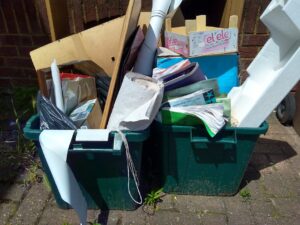What is ‘contamination’ and why is it important?

It is really important that we keep the contamination levels in our recycling as low as possible.
Contamination makes sorting the recycling much more difficult and expensive and can reduce the quality and value of the recyclable materials. If contamination levels in a particular lorry-load of recycling are too high, there is a chance that the recycling plant will reject the entire load, and it will have to be treated like general waste and sent for disposal instead. This is more expensive than recycling it and less environmentally sustainable.
Contamination can also occur if plastic bags are used to separate out recycling or to line food waste caddies (the recycling plants are not able to process plastic bags and can reject an entire load if there are too many of them).
If our collection crews can see that a bin, box, caddy or bag is contaminated, then they are instructed not to collect it. They should leave an advice tag telling you what the problem is (see: Presenting your bins correctly on collection day).
Please help us reduce contamination by ensuring you place the correct materials in the correct bin and by not using plastic bags to separate out your recycling or line your food waste caddy.
Use our ‘BinSmart‘ directory of common household items to find out which bin things should go in.